Why have you opted for a flat on-axis passband? Wouldn't it benefit from a degree of adjustment in the manner of B&W in order to move the perceived timbre more towards neutral/natural? Or is the speaker perhaps a stack of horns?
(Very) 'Big' meh.
And Mark can adjust every parameters at will. It's fully dsped with pro gear.
....
Q of box/drivers arent affected by the room but if room is leaky ( in low end) or a concrete shell the couple formed by loudspeaker/room have very different requirements.
I found using closed+LT to be the most flexible answer regarding this as you can adapt at the turn of some buttons.
BR would need a box redesign.
The hybrid approach Macka advice have been used in JBL domestical 'big loudspeakers' from 90's K2 S9500/M9500. Never heard this so can't comment about.
Last edited:
And that pretty Bessel alignment goes out the window as soon as you start using the system at normal volume or placing the speakers in a normal living room, because of the typical non-linearities of the T/S parameters and low freq behaviour of the room. So obtaining an alignment like this have little to no practical value IMO.
I didn't see any measurements that backs up PMCs claim. Instead the low freq responses of it's speakers is wobbly, with high Q resonances.
https://www.stereophile.com/content/pmc-fact8-signature-loudspeaker-measurements
I don't know domestical Pmc range but the one i've heard were meant to be eqed on place to adapt to room ( like 99% of pro 'mains' including ATC).
They had issue but not what you point: a member here defined it as 'hangover' in very low, because of bass reinforcement they used in the TL which imply a bit of delay wrt to initial wavefront.
The transient response of the one i heard didn't catch my attention but the low dist in octave just below mid dome was audible.
It's a kind of rendering, they all have their pro and cons.
Last edited:
You can't make the baffle shape a figure-of-8 to approximate the front of a neighbouring cylinder? It would seem an odd restriction if not.
Hi, here quick sims with figure of eight baffle:This you could do yeah. In reality you could space them out a bit, not touching each other which likely reduces the interference because if the first edge diffracts, there is bit less amplitude left to diffract again, also the furthest edge (bottom of woofer, thinking sound that starts from mid), would be quite far and be quite short compared to "sound bubble" size so minor effect compared to the first edge diffraction effects.
Here how they look in diffraction sim, stand alone and then in figure of eight
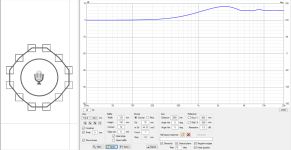
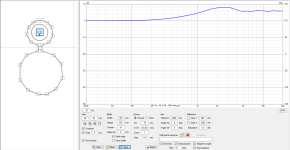
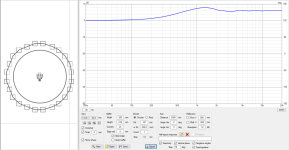
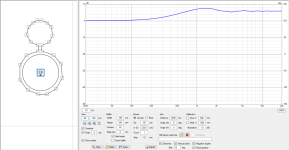
Here exported graphs, should be in same order as above images.
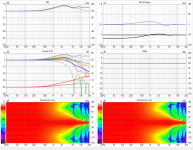
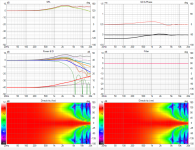
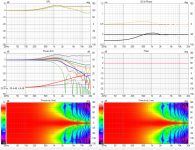
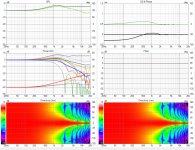
As seen effect of adjacent transducer structure (pipe) is minor at least here in this simple simulation, and I suspect BEM would also show kind of minor effects as long as both are on same plane so that there is no path for specular reflections to reach listener.
Any second or higher order diffractions, like those from back of the structure or from neighbouring structure, just makes ripple that rides over the response that happens due to the direct sound and front edge of the baffle that is immediately beside the transducer encompassing it. This is because sound does superposition, the louder the interfering sound source is the more significant the effect. Two perfectly coherent and equal SPL signals can make +6db constructive interference and in theory cancel perfectly in between, but if either is louder it would dominate the response, while the other makes some ripple to it. Hence we see significant effect of the baffle edge diffraction from the immediate surroundings of the transducer because there the SPL is loudest, but soon after the first edge the SPL already drops and anything beyond has less and less effect just due to less SPL.
As computed in brain in previous example, a woofer "enclosure" below freestanding mid enclosure makes very little difference in response of the mid, because it does not encompass the mid driver but only very small portion of mid sound encounters the woofer structure. The neighbouring structure does not encompass the mid transducer as the mid enclosure itself, which the mid sound would fully encounter. Thus, the immediate surroundings of any transducer makes most of the effects, dominates the interference / pattern, and anything second order effects just ride on top, make minor ripple on top of it.
edit.
here simple ballpark demonstration that any first order effect makes most difference in response, while second order or higher order effects just make ripple on top of it. Crude simplified emulation of ideal direct sound with flat frequency response, then secondary sound with limited bandwidth arriving bit later, rough emulation of front edge diffraction, which makes quite big interference pattern with direct sound. And then the second order effect, like another rough emulation of diffraction from back of the box, just ripples it, doesn't dramatically alter what the first edge already did, a lessor effect on graphs.
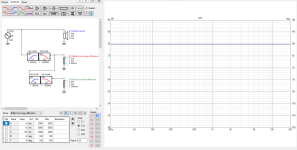
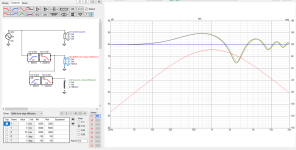
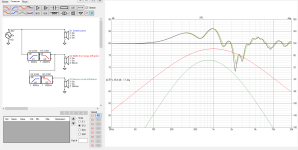
Make no mistake, I think the second order effect might be the more audible one due to how auditory system works! I'm not an expert and these are difficult to listen to so just a hunch. But, if ones goal for system response is to get within say +-1db target through the whole bandwidth, it is most important to fix the first order effects because those make most difference! Immediate surroundings of a transducer is the most important thing to get right acoustically.
Last edited:
(Very) 'Big' meh.
And Mark can adjust every parameters at will. It's fully dsped with pro gear.
Can you expand on what this means and whether Mark's speaker has a wide beamwidth on a narrow/small baffle like the OP's or is a stack of horns (a fairly common configuration for a 5 way). The difference is relevant to the perceived sound.
What the OP is proposing is going to introduce some pretty noticeable sound effects due to the steep changes in radiation pattern with frequency. It can be compensated for to some extent by raising and lowering the on-axis response to counter the relatively wide and narrow beam widths but this is rare. I am only aware of B&W taking the approach. Anyone? Other wide bandwidth speakers and particularly the ones that do well in listening tests have smooth radiation patterns created by blending the differing radiation patterns with the crossover. FIR filters can do this noticeably better than analogue filters although the filter design isn't straightforward.
The OP can of course try steep filters, hear what the sound like and then implement a crossover with shallower slopes so long as the drivers he chooses are suitable (there was some discussion earlier about filler drivers). Given the absence of speakers with steep crossover slopes on the market this is likely a good way to hear/learn why. Perhaps he will like the effect and keep the steep slopes but I think it unlikely. All part of the fun of the hobby.
Why have you opted for a flat on-axis passband? Wouldn't it benefit from a degree of adjustment in the manner of B&W in order to move the perceived timbre more towards neutral/natural? Or is the speaker perhaps a stack of horns?
Hi, I tune all my DIYS for as flat as possible on-ax, that also have smooth sets of off-ax. Gives me a known commodity to start with, in whatever room/environment.
Then, on a separate EQ level, I apply house curve(s)...situation dependent.
As Krivium said, the speakers are fairly large conical MEHs. So all 4 main-speaker driver sections are in one 90x60 degree horn.Can you expand on what this means and whether Mark's speaker has a wide beamwidth on a narrow/small baffle like the OP's or is a stack of horns (a fairly common configuration for a 5 way). The difference is relevant to the perceived sound.
What the OP is proposing is going to introduce some pretty noticeable sound effects due to the steep changes in radiation pattern with frequency. It can be compensated for to some extent by raising and lowering the on-axis response to counter the relatively wide and narrow beam widths but this is rare. I am only aware of B&W taking the approach. Anyone? Other wide bandwidth speakers and particularly the ones that do well in listening tests have smooth radiation patterns created by blending the differing radiation patterns with the crossover. FIR filters can do this noticeably better than analogue filters although the filter design isn't straightforward.
Ime, radiation pattern vs freq is a function of the acoustic design, the physical design, and that design pretty much mandates where the electrical crossovers should be placed for smoothest polar response.
I've found it much easier to crossover right at that optimal acoustical target, with steep rather than shallow xovers.
Drivers still need to be selected fairly carefully for sufficient overlap, but it is so much easier to tie together drivers where they maintain fully complementary acoustic summation thru xover region.....again, at the optimal frequency dictated by the acoustic design.
So I guess i'm saying...i see steep working no matter what the acoustic design. Just start with a good acoustic design!!
Hope that all made sense.
Thanks for taking the time to do this. It is actually fairly time consuming to use the Vcad diffraction tool for odd-shaped baffles like this.Hi, here quick sims with figure of eight baffle:
I also start with a flat on-axis response. It makes it easier to confirm the system level measurements match the simulation, and it is a good place to start the voicing process.Hi, I tune all my DIYS for as flat as possible on-ax, that also have smooth sets of off-ax. Gives me a known commodity to start with, in whatever room/environment.
So I guess i'm saying...i see steep working no matter what the acoustic design. Just start with a good acoustic design!!
Hope that all made sense.
It works in your case because the horn is largely controlling the sound radiation pattern. The OP's proposal is to use a small baffle where the good acoustic designs (e.g. Revel, Vivid, etc...) use the crossover to smoothly mix the different driver sound radiation patterns over a rounded baffle to achieve a wide pattern that varies in a smooth and controlled manner with frequency. A substantially different case requiring significantly more effort to achieve good results but it can deliver a wider beamwidth (pros and cons) than is usually the case with horns. Very steep crossover slopes will create sharp changes in radiation pattern even with the use of 4 rather 3 ways and is not what is needed if a perceived neutral tonal balance is an objective. EQ/voicing can be used to make the sharp changes in off-axis radiation less intrusive by introducing counteracting bumps and dips in the on-axis reponse but it can't fix it. Fixing requires designing for a smoothly controlled radiation pattern. Much of this could of course be easily achieved at no financial cost by simply changing the filters to something more appropriate so likely not a serious an issue.
The OP's proposal is to use a small baffle where the good acoustic designs (e.g. Revel, Vivid, etc...) use the crossover to smoothly mix the different driver sound radiation patterns over a rounded baffle to achieve a wide pattern that varies in a smooth and controlled manner with frequency. A substantially different case requiring significantly more effort to achieve good results but it can deliver a wider beamwidth (pros and cons) than is usually the case with horns. Very steep crossover slopes will create sharp changes in radiation pattern even with the use of 4 rather 3 ways and is not what is needed if a perceived neutral tonal balance is an objective.
I don't think it's as complicated as you're making it, for the designs being prosed. In fact, I think the smooth blending gets likely easier with steep.
But maybe you're right...what does Vcad say?
edit: and pls don't forget if/when modeling, steep implies the use of linear -phase xovers, which decomplicates enormously
Last edited:
Wow, this thread's OP question was
So, I began to wonder what if I add midbass between ATC and 8" double woofers. My logical half tells me professionals and experts will say midbass is not necessary with 8" double woofer below. But I am still curious. What are your thoughts about this?
Regards,
Jay
So, I began to wonder what if I add midbass between ATC and 8" double woofers. My logical half tells me professionals and experts will say midbass is not necessary with 8" double woofer below. But I am still curious. What are your thoughts about this?
Regards,
Jay
😀 well, it is good to read the OP every now and then 😀
Perhaps the original Q was answered long time ago, but I'd say do what bass you wanna, I'm not sure I'd use 8" basses, nor mid domes 😀 but that's just me, never arrived to system that would use those while thinking a suitable system for me, at least so far 🙂 perhaps if I happened to have those. I'm using 1" compression driver in a waveguide, 8" mid and 15" bass, completely different system, four way system though, subs included. There are plenty of possible systems and plenty of reasons to build any particular one. 8" mid bass below 3" dome might be good, and then another bass system. Perhaps two 8" works fine and doesn't need separate bass system, one could calculate and simulate if there is any goals and whether those are met.
Perhaps the original Q was answered long time ago, but I'd say do what bass you wanna, I'm not sure I'd use 8" basses, nor mid domes 😀 but that's just me, never arrived to system that would use those while thinking a suitable system for me, at least so far 🙂 perhaps if I happened to have those. I'm using 1" compression driver in a waveguide, 8" mid and 15" bass, completely different system, four way system though, subs included. There are plenty of possible systems and plenty of reasons to build any particular one. 8" mid bass below 3" dome might be good, and then another bass system. Perhaps two 8" works fine and doesn't need separate bass system, one could calculate and simulate if there is any goals and whether those are met.
Last edited:
I had a look at the woofer list.
The best were either of the Scanspeak or the Volt woofers. The others aren’t worth thinking about. The Scan drivers have low inductance which is good indicator of a well engineered driver.
The simulation of a woofer in an enclosure is fairly matter of fact below 100 hertz. I would recommend a flat baffle supporting both woofers. Despite your desire for a narrow baffle it will still help load the drivers near the floor.
Because you’re only going up to 400 hertz your best bet is to place one woofer in it’s sealed volume and the other in an optimal vented alignment.
This will give you depth and speed in your bass.
In essence your sealed woofer acts as a mid bass driver. The sealed woofer is at the top with the vented woofer near the floor.
Halve the volume in the screen shot for a single woofer in a vented enclosure.
Add you floor loading and you have quite a robust low frequency system down to the low 30’s. I would rear vent the port as it will be a reasonable length in this size enclosure.
Looking at the table myself, I realized that SB woofers are pretty cheap and also looking good on paper. Scanspeak ones are quite expensive. I suddenly became to wonder, what if I use 4 SB 8"? Any idea or gut feeling?
Wow, this thread's OP question was
So, I began to wonder what if I add midbass between ATC and 8" double woofers. My logical half tells me professionals and experts will say midbass is not necessary with 8" double woofer below. But I am still curious. What are your thoughts about this?
Regards,
Jay
Thanks for brining it back. But now I am more inclined to using cheaper(!) alternatives(Satori dome and illuminator 7"). ATC dome will probably cost around $900 if I can buy one. S version is even more expensive.
I don't think it's as complicated as you're making it, for the designs being prosed. In fact, I think the smooth blending gets likely easier with steep.
But maybe you're right...what does Vcad say?
edit: and pls don't forget if/when modeling, steep implies the use of linear -phase xovers, which decomplicates enormously
I guess I understand both arguments. What I didn't come up with or say was that, 4-way design allows the use of the best FR of each driver in terms of everything including its dispersion. So the dispersion of even the higher frequency drivers are fairly wide(less directional peak or lobbing?), so kind of forms smooth or acceptable radiation band in the entire audible band. Does this make any sense?
They might be cheap but they have limited Xmax.Looking at the table myself, I realized that SB woofers are pretty cheap and also looking good on paper. Scanspeak ones are quite expensive. I suddenly became to wonder, what if I use 4 SB 8"? Any idea or gut feeling?
I recall you have already two Volt woofers.
If it’s the 2500.1 just use it to get you started.
The the enclosure is tall the enclosure will not look wide
You could use four 8 inch woofers.
I think multiple drivers for optimised bandwidth belong to listening distances of 3 meters or more. You also have what happens to the 1st reflections. There will be a reflection for each driver. 😦.
Ideally you want the sound of each driver have converge before the 1st reflection. I don’t see that occurring in a typical living space. This is why such systems can be more a wall of sound than a source with a well defined sound stage with precise imaging.
Quote
“I have an ATC-based 3-way already, so I guess one of many points of this project is to do something different from the past....”
I think the idea of the ATC 3 way design is fine technically but that is a monitor used in a room with treated acoustic and close listening distance. ATC is very focused on the drivers. I have heard ATC systems.
Listening to sound reproduction in a home living room is actually different.
We are not looking for microscope errors in the mix at clinical levels. That is fatiguing.
We are looking for rendering of the recording that imparts the artists appreciation of a tune and the recording engineer. The idea is that it translates an emotional response from the listener.
But we don’t won’t every recording to sound nice or the same either. Those are budget loudspeakers that project their own personalities. You need to hear how the musical instrument is being played. Is it a Steinway or a Yamaha piano? The melodies, pace, the rhythm and the timing of the tune all stimulate our emotions. If you over complicate how that emerges you could loose the plot.
Design to appeal to how the human ear works.
A tightly clustered mid - hf array resolves a lot of the disadvantages of a multi way loudspeaker system.
The loudspeaker also has to suit your room.
This is where the spatial accuracy of a multi way system is critical. The effects of diffraction, driver placement and cross over point are all aimed to keep these problems under the radar of the human ear’s threshold of detecting errors.
Thats much easier to do with a tight cluster of drivers.
The key determinants of the human sound decoding are variations in loudness and the phase relation between both ears. This is how we localise the source of a sound. Then the stimulus of the low frequency beat. The more accurate the beat the more likely you will be stimulated.
But no two listeners are alike. So is the distance they like to listen to the original event or the kind of music they like.
So the loudspeaker has to convey those traits.
But if you’re looking at it all very technically you can easily miss the hand full of things that actually matter to our ears and our hearts. This is why listening is actually subjective.
“I have an ATC-based 3-way already, so I guess one of many points of this project is to do something different from the past....”
I think the idea of the ATC 3 way design is fine technically but that is a monitor used in a room with treated acoustic and close listening distance. ATC is very focused on the drivers. I have heard ATC systems.
Listening to sound reproduction in a home living room is actually different.
We are not looking for microscope errors in the mix at clinical levels. That is fatiguing.
We are looking for rendering of the recording that imparts the artists appreciation of a tune and the recording engineer. The idea is that it translates an emotional response from the listener.
But we don’t won’t every recording to sound nice or the same either. Those are budget loudspeakers that project their own personalities. You need to hear how the musical instrument is being played. Is it a Steinway or a Yamaha piano? The melodies, pace, the rhythm and the timing of the tune all stimulate our emotions. If you over complicate how that emerges you could loose the plot.
Design to appeal to how the human ear works.
A tightly clustered mid - hf array resolves a lot of the disadvantages of a multi way loudspeaker system.
The loudspeaker also has to suit your room.
This is where the spatial accuracy of a multi way system is critical. The effects of diffraction, driver placement and cross over point are all aimed to keep these problems under the radar of the human ear’s threshold of detecting errors.
Thats much easier to do with a tight cluster of drivers.
The key determinants of the human sound decoding are variations in loudness and the phase relation between both ears. This is how we localise the source of a sound. Then the stimulus of the low frequency beat. The more accurate the beat the more likely you will be stimulated.
But no two listeners are alike. So is the distance they like to listen to the original event or the kind of music they like.
So the loudspeaker has to convey those traits.
But if you’re looking at it all very technically you can easily miss the hand full of things that actually matter to our ears and our hearts. This is why listening is actually subjective.
I don't think it's as complicated as you're making it, for the designs being prosed. In fact, I think the smooth blending gets likely easier with steep.
But maybe you're right...what does Vcad say?
Without waveguides there is no blending with steep filters just a sharp change over a few Hz from the narrow radiation of the larger driver to the wide radiation of the smaller driver. Although unnatural it is not a wholly negative sound effect and with DSP crossovers it is straightforward to play around with.
As discussed earlier virtuixcad can only provide a rough idea (e.g. #503) because it simulates baffle edge diffraction rather than guided sound in 3d. This can provide some guidance on the likely size of the bumps and dips rather than how to control them. Akabak might help with the latter for those that are keen. If the OP opts for stacked cylinders then there likely isn't much design optimisation involved beyond whether to radius the edges or not.
Hi, Andy
You make the assumption the 'large' drivers are used past their wide directivity range. It can be done differently.
Or maybe i misunderstand your point?
Macka, once again you nicely summarised the situation in latest post you made imho.
Like you i understood Jheaustin already had a pair of ATC mids.
Which bring us back to a list of priority in the design in my view:
What Jheaustin is looking for in the kind of rendering should be high on the list as well as the number of way if he wants some 4 ways.
From there it narrows some design choices, then another set of constraint for the design until main acoustical and physical design is starting to emerge.
Of course it suppose Jheaustin know what he is looking for ( i'm in no way condescending in that, it took me ages to know what i like as there is many ways possible to achieve same goals...and i'm still not totally sure of what i like the most as i could live with many 'good' ( to me) loudspeakers).
My previous message listing ATC mids drivers loudspeakers i've heard wasn't to show off, just to point that in pro field they are most of the time used on wide or infinite baffle ( inwall) and in very damped rooms. Most of the time the sweetspot for lowest driver used is circa at minimum 1x15" membrane area, more often than not 2 to 4 time this sd...
I already explained why in a previous post and why this is not something i would bring home ( very wide directivity which ask for acoustic treatment to shine at his best. Iow it shift to room a lot of constraints for them to be at their best - and why pro acousticians loves working with them: they have very constant directivity behavior on a very wide freq range, hence simplify modelling and what to expect once located in room).
Now if dome mid aren't used anymore then it open for other design choices. But first if Jheaustin could give what he would like it could be easier to track what could or not work.
You make the assumption the 'large' drivers are used past their wide directivity range. It can be done differently.
Or maybe i misunderstand your point?
Macka, once again you nicely summarised the situation in latest post you made imho.
Like you i understood Jheaustin already had a pair of ATC mids.
Which bring us back to a list of priority in the design in my view:
What Jheaustin is looking for in the kind of rendering should be high on the list as well as the number of way if he wants some 4 ways.
From there it narrows some design choices, then another set of constraint for the design until main acoustical and physical design is starting to emerge.
Of course it suppose Jheaustin know what he is looking for ( i'm in no way condescending in that, it took me ages to know what i like as there is many ways possible to achieve same goals...and i'm still not totally sure of what i like the most as i could live with many 'good' ( to me) loudspeakers).
My previous message listing ATC mids drivers loudspeakers i've heard wasn't to show off, just to point that in pro field they are most of the time used on wide or infinite baffle ( inwall) and in very damped rooms. Most of the time the sweetspot for lowest driver used is circa at minimum 1x15" membrane area, more often than not 2 to 4 time this sd...
I already explained why in a previous post and why this is not something i would bring home ( very wide directivity which ask for acoustic treatment to shine at his best. Iow it shift to room a lot of constraints for them to be at their best - and why pro acousticians loves working with them: they have very constant directivity behavior on a very wide freq range, hence simplify modelling and what to expect once located in room).
Now if dome mid aren't used anymore then it open for other design choices. But first if Jheaustin could give what he would like it could be easier to track what could or not work.
Last edited:
I think the above post is a good way to take stock.
I look forward to Jheaustin providing some more insights into his needs. I think an understanding of his journey in loudspeakers would also help us understand what the next project might look like.
Of course sometimes we don’t understand the technical needs. This is why l illustrated that we are all different as listeners
How we listen to original performers (when we have the opportunity)
Front row
10 seats back
Middle row
Rear row
The kind of music you listen to ?
A list of your prior and current loudspeakers
A summary of what you liked and didn’t like about them ?
What you want more of?
What you want less off?
At the original performance what is it that triggers your emotions about the sound you hear ?
The melody?
The rhythm of the tune?
The timing of drums and percussion musical instruments
Solo vocal, chorus
What do you tend to focus on at home when listening?
There is no right or wrong to any of your responses.
I look forward to Jheaustin providing some more insights into his needs. I think an understanding of his journey in loudspeakers would also help us understand what the next project might look like.
Of course sometimes we don’t understand the technical needs. This is why l illustrated that we are all different as listeners
How we listen to original performers (when we have the opportunity)
Front row
10 seats back
Middle row
Rear row
The kind of music you listen to ?
A list of your prior and current loudspeakers
A summary of what you liked and didn’t like about them ?
What you want more of?
What you want less off?
At the original performance what is it that triggers your emotions about the sound you hear ?
The melody?
The rhythm of the tune?
The timing of drums and percussion musical instruments
Solo vocal, chorus
What do you tend to focus on at home when listening?
There is no right or wrong to any of your responses.
Hers is an interesting observation
How it it at a shopping mall you can always tell when someone is playing a musical instrument?
It might be a long way away but you know what it is and it draws you closer.
How it it at a shopping mall you can always tell when someone is playing a musical instrument?
It might be a long way away but you know what it is and it draws you closer.
I guess I understand both arguments. What I didn't come up with or say was that, 4-way design allows the use of the best FR of each driver in terms of everything including its dispersion. So the dispersion of even the higher frequency drivers are fairly wide(less directional peak or lobbing?), so kind of forms smooth or acceptable radiation band in the entire audible band. Does this make any sense?
Yes it makes sense and is defacto one of ATC design goal: constant directivity pattern over a very wide freq range (140° at -6db).
- Home
- Loudspeakers
- Multi-Way
- 4-way instead of 3-way?